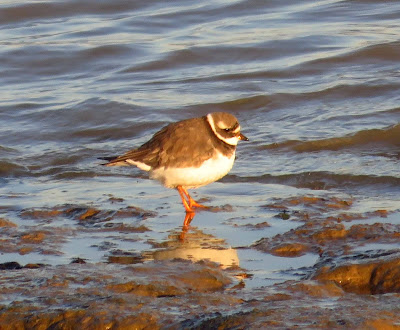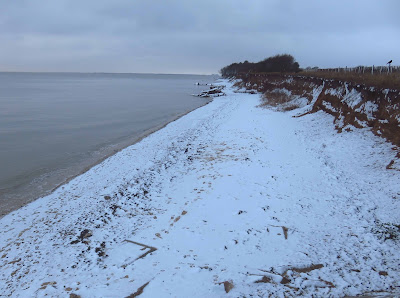It's been a blustery end to the year with grey skies, breezy and wet at times. Walked the Strood seawall a couple of times over the weekend with high tides receding late mornings allowing a good variety of waders onto the channel.
This redshank was feeding close to the seawall, one of about 300 redshank in the channel on Sunday 31st
Three ruff were feeding with 14 grey plover in a flooded field, later two of them were back on the mudflats on Sunday. One ruff flew onto the flooded corner of the field from the Strood on Saturday.
Ten black-tailed godwits were seen on both Saturday and Sunday along the Strood. The most numerous waders were the 1000 dunlin, 300 golden plover in a ploughed field and 20 ringed plovers feeding in one of the fields on Saturday.
This redshank was feeding close to the seawall, one of about 300 redshank in the channel on Sunday 31st
Three ruff were feeding with 14 grey plover in a flooded field, later two of them were back on the mudflats on Sunday. One ruff flew onto the flooded corner of the field from the Strood on Saturday.
Ten black-tailed godwits were seen on both Saturday and Sunday along the Strood. The most numerous waders were the 1000 dunlin, 300 golden plover in a ploughed field and 20 ringed plovers feeding in one of the fields on Saturday.
The main brent goose flock of 2000 birds were feeding in a wheat field on the Peldon side, every so often the flock taking to the air and landing in the Ray Channel. Other wildfowl along the Strood were 50 shelduck, 70 wigeon and 50 teal, also 15 little grebes while a red-breasted merganser was seen from the Hard.
A marsh harrier and sparrowhawk were seen over the Ray Island on Sunday morning. The previous day a peregrine flew down channel scattering all the birds before it headed over to the Feldy marsh. Also a marsh harrier on Saturday flying over Feldy.
On the Strood fishing lakes on Sunday were 14 tufted duck, 36 mallard, 2 little egrets, 2 great crested grebes, grey heron and a Mediterranean gull.
Three stonechats were seen near the Strood dyke and central ditch on Sunday, just one bird seen on Saturday.
A brief visit to the Strood on Friday 29th revealed a red-breasted merganser in the channel while in the stubble field up by the houses were 50 carrion crows, 10 jackdaws and 50 skylarks.
A first winter glaucous gull was seen by Simon Wood flying past Coopers Beach heading into the Blackwater on Sunday 31st.
On Thursday 28th December 17 marsh harriers, merlin, peregrine, barn owl and 8 red-breasted mergansers were seen by Darrell Stile from East Mersea viewing the Langenhoe harrier roost.
One of the regular male red squirrels was back at the feeder in the Firs Chase garden on Sunday morning. There hasn't been much activity at the feeder during December, possibly due to the colder weather.
A red squirrel was also seen on Xmas Eve by Martin Cock as it scampered across his garden in the Coverts for the first time. A visitation from someone wearing a red outfit on Xmas Eve! A nice present for the whole family!
A marsh harrier and sparrowhawk were seen over the Ray Island on Sunday morning. The previous day a peregrine flew down channel scattering all the birds before it headed over to the Feldy marsh. Also a marsh harrier on Saturday flying over Feldy.
On the Strood fishing lakes on Sunday were 14 tufted duck, 36 mallard, 2 little egrets, 2 great crested grebes, grey heron and a Mediterranean gull.
Three stonechats were seen near the Strood dyke and central ditch on Sunday, just one bird seen on Saturday.
A brief visit to the Strood on Friday 29th revealed a red-breasted merganser in the channel while in the stubble field up by the houses were 50 carrion crows, 10 jackdaws and 50 skylarks.
A first winter glaucous gull was seen by Simon Wood flying past Coopers Beach heading into the Blackwater on Sunday 31st.
On Thursday 28th December 17 marsh harriers, merlin, peregrine, barn owl and 8 red-breasted mergansers were seen by Darrell Stile from East Mersea viewing the Langenhoe harrier roost.
One of the regular male red squirrels was back at the feeder in the Firs Chase garden on Sunday morning. There hasn't been much activity at the feeder during December, possibly due to the colder weather.
A red squirrel was also seen on Xmas Eve by Martin Cock as it scampered across his garden in the Coverts for the first time. A visitation from someone wearing a red outfit on Xmas Eve! A nice present for the whole family!



















































